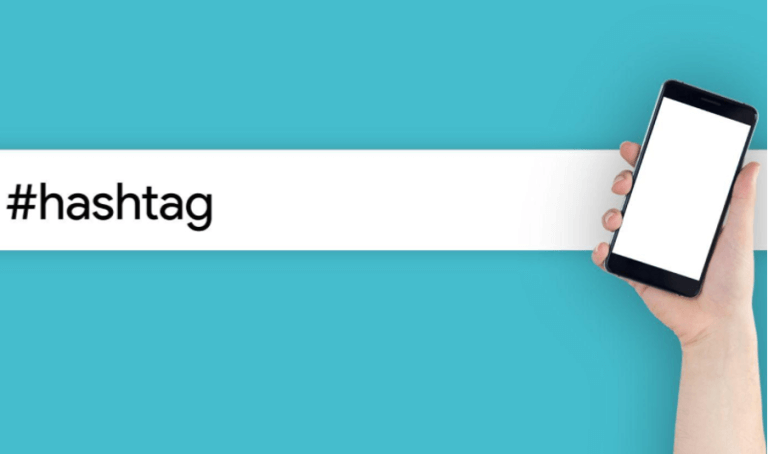How to Use Hashtags to #DriveEngagement Now

In 2022, an estimated 3.96 billion people will use social media. If you’re one of those people, you’ve almost certainly seen thousands of hashtags splashed across glam pics on Instagram, hot takes on Twitter, and family snaps on Facebook.
But have you ever wondered about the origins of the recognizable “#” sign? Believe it or not, “hashtag” wasn’t always synonymous with “social media.” It also wasn’t always part of a part of a killer digital marketing strategy.
In this article, we’ll dive into the world of hashtags to explore what they are, why they matter, and how to use them effectively to boost your brand’s digital marketing efforts on social media.
What’s a hashtag?
A “hashtag” is a phrase, sentence, or word that comes after the”#” sign, i.e., #vacationmode, #livingmybestlife, #winning #Hawaii.
The “#” sign is also known as an “octothorpe,” “cross-hatch,” or “hash,” depending on your location.
Hashtags are sort of like a filing system for social media content. Users tag posts relevant to a topic with the “#,” and social media platforms place the content in a category with other, similar content. People can search posts under different tags to find content connected to info they’re searching about.
Here’s an example of the results for #veggieburger on Instagram:
In 2022, we most commonly associate hashtags with social media – but they’re far older than you may expect.
Back in 1988, a platform called Internet Relay Chat (IRC) first used tags to sort videos, images, group messages, and text content by category. Then, in 2007, Twitter started to use the “#” sign. Specifically, Chris Messina suggested it as a way to group similar content together for users.
The first publicly-known tweet containing a hashtag is this one – published by Chris Messina on Aug. 24, 2007:
how do you feel about using # (pound) for groups. As in #barcamp [msg]?
— ˗ˏˋ Chris Messina ˎˊ˗ (@chrismessina) August 23, 2007
As you might imagine, the first hashtag was “barcamp.”
Now, not everything with the “#” symbol is a hashtag. To be considered an effective hashtag, it needs:
- No spaces (#launchparty not #launch party )
- No punctuation October2007 not #October,2007)
- Less than 24 characters (it can be longer, but shorter hashtags perform better)
Why use hashtags for marketing?
Hashtags are important for social media algorithms because they can’t understand language the way humans can. Instead, they rely on keywords and hashtags to interpret a post’s content and file it appropriately.
Hashtags help users streamline their scrolling so they only see content they’re interested in. You can see posts about cosmetics in #makeupaddiction, for example, or posts about running in #runnerslife.
And, of course, if you’re a social media marketer, hashtags can help you:
- Boost engagement
Without hashtags, only the people who follow you, search for your profile or spot you on trending would see your posts. Hashtags expand your posts’ reach onto the feeds of people searching for content like yours.
In a similar vein, hashtags encourage people to engage with you. Some hashtags ask questions or seek people’s opinions, for example. People will respond to these hashtags in the comments, thus increasing your social media engagement (and, in turn, your reach).
Other hashtags encourage people to create user-generated content (UGC). Doritos famously does this with the hashtag #fanfriday. People who like Doritos create Doritos-inspired art, and Doritos reposts it for engagement and clout. That way people could check out related posts.
- Keep up with trends
Trending topics often have an accompanying hashtag you can use in your post. When you use this hashtag to create relevant content, your content may start to trend, too.
Thus, (assuming you create engaging content), capitalizing on trends with hashtags is a great way to get views, clicks, and comments.
- Boost your branding
Finally, you can use consistent hashtags on your posts to build a recognizable name and image for your brand (like #targetrun for Target). Then, when people see this hashtag in the digital wild, they’ll think of you – boosting your presence in the minds of followers, customers, and potential leads.
Think of a hashtag like the text-based version of Cadbury’s iconic purple branding or Doritos’ signature triangle chip shape. It’s kind of like a social media version of a watermark or logo.
Many brands also use their own names as hashtags to get phenomenal views. For example, the top trending skincare brand on TikTok in July 2020 was The Ordinary. #theordinary scored a whopping 949 million hashtag views, double that of global beauty icon Dove.
Other skincare brands with branded hashtags also fared pretty well, as you can see from Statista:
You could also grab views with your brand hashtag if you work at it.
How to use hashtags
Once you know what hashtag you want to use (if you don’t, skip to “How to Create a Hashtag”), the steps involved are fairly straightforward for Facebook, Twitter, and Instagram.
You simply start a new post, add the “#” sign (on most keyboards, it shares a key with the “3”), and type your hashtag. Then, complete your post and push “publish.”
Facebook hashtags look like this:
Twitter hashtags look like this:
In #SEO, many marketers and brands tend to focus solely on ranking for content on their own websites.
This approach misses the bigger picture of the performance of your content on third-party sites such as YouTube, Twitter, sales outlets, media sites, and partner sites. pic.twitter.com/8hQa9dSyCG
— Similarweb (@Similarweb) March 31, 2022
And Instagram hashtags look like this:
Make sure your hashtags are set up correctly before you post, since editing your post after you notice your hashtag doesn’t link anywhere can hurt your visibility.
If your hashtag still isn’t working, double-check that you’ve set your account to “public,” not “private.” If you have a private account, non-followers can’t see your content, and your posts won’t appear in hashtag search results.
Once your hashtag is live, you (and other social media users) can browse your hashtag by clicking on it. If you click #productivity, for example, you’ll see a feed like this:
How to create a hashtag that actually gets clicks
So, you now know the basics of hashtags. But how do you actually create a good one? Try these steps:
Step 1. Set your intention and topic. What do you want this hashtag to do for you? Are you trying to start a conversation? Do you want people to comment in response? Give your hashtag a theme and a topic that will interest people.
Step 2. Brainstorm potential ideas. Try to develop a long list of suggestions, then combine your favorites until you have two to five strong possibilities. If you want inspiration, try using the Similarweb keyword research tool. It can help you discover new keywords, assess the competition, and build a smart keyword strategy.
Step 3. See if your hashtags are already in use. Search for your hashtags on all major platforms (Facebook, Instagram, Twitter, YouTube, TikTok, etc.). If someone else has already claimed a hashtag, scratch it off your list.
Step 4. Do your research. Take a closer look at your potential hashtags and try to spot anything that someone could accidentally get confused about. As hashtags have no spaces between words, many brands have run into trouble using hashtags with double meanings.
You might remember arguably the most famous of these disasters – when Susan Boyle’s public relations (PR) team promoted the launch of her new album in 2012 with #susanalbumparty (later changed to the more appropriate #susanboylealbumparty).
Step 5. Select a winning hashtag and start using it. Take your strongest hashtag and add it to your new social media posts. You can place hashtags anywhere you like, including at the start of posts, inside copy, at the end of your post, or in the comments.
Step 6. Assess your hashtag’s effectiveness. If the hashtag is working, great! Otherwise, try tweaking it until your target audience responds positively to it. Try switching up the phrasing format, exchanging words, and altering where you put the hashtag in posts.
Note: During the hashtag creation process, there’s something you need to remember: you can trademark your hashtag to protect it from other brands, but you can’t stop social media users from engaging with it however they want.
In the past, people have taken hashtags as part of larger campaigns like #mcdstories (created by McDonald’s) and #waitrosereasons (created by supermarket chain Waitrose) and spammed them with negative posts. Trolls are an unfortunate part of social media – so consider how they might respond to your hashtag and how you’ll handle it.
Hashtag best practices
Popular hashtags like #picoftheday have stayed popular for years, and brands like Nike have had serious success with hashtags like #swoosh. On the flip side, hashtags like #susanalbumparty have garnered negative attention and publicly embarrassed the social media teams responsible for them.
So, aside from not containing accidental double meanings, what do successful hashtags do that unsuccessful ones don’t? They follow these hashtag best practices:
- Use short and simple phrases, like #picoftheday vs. #myfavoritephotofrommydaytoday
- Make it natural Make it catchy, like slogans
- Keep it simple and accessible, especially when you’re trying to reach a wide audience around the world
Hashtags for Facebook, Instagram, and Twitter #success
Hashtags aren’t just fun phrases that can spice up your posts. Hashtags help social media platforms aggregate content so users can browse it quickly and easily. When you use hashtags to your advantage, you can boost your posts’ reach, engage a new audience, and make your branding recognizable.
To create a hashtag of your own, brainstorm ideas, research your options, and choose a hashtag your audience will relate to.
And, if you want to streamline your research process, use Similarweb robust Digital Marketing Intelligence tools to identify competitive keywords from over 1 billion search terms and inspire your hashtag game.
The #1 content marketing tool - get started
Give it a try or talk to our marketing team — don’t worry, it’s free!














